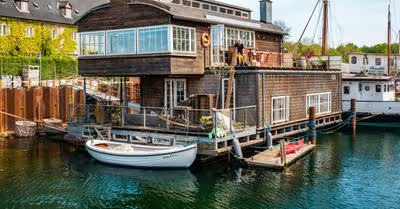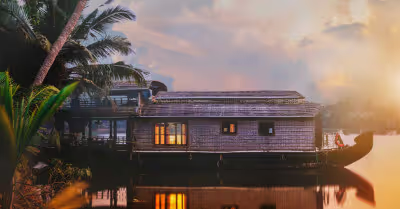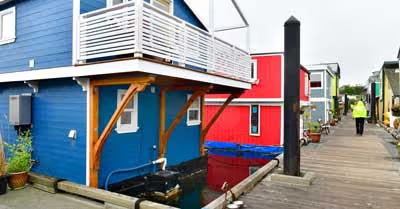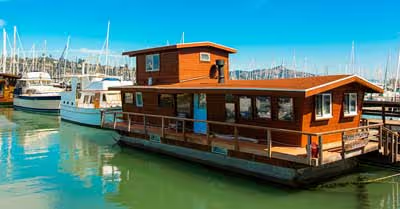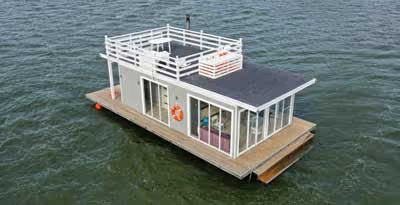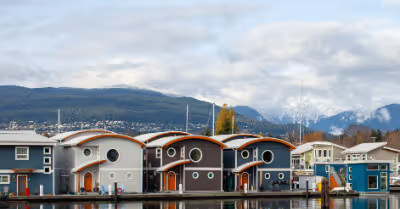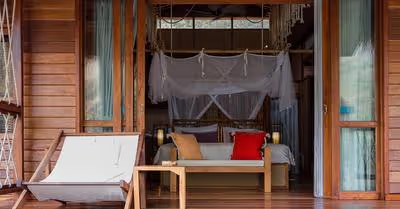
Houseboat interiors vary widely, but some are clearly better and more comfortable than others. Smart houseboat interior design is more important than size.
The best houseboat interior designs make efficient use of limited space. They incorporate open, multi-use spaces and large windows for light and ventilation. The best houseboat interior design companies are Stardust Cruisers and Gibson Houseboats.
In this article, we’ll go over the aspects of the best houseboat interior designs and what to look for when ordering your new houseboat. Additionally, we’ll cover common interior designs of both stationary and cruising houseboats. Finally, we’ll go over two houseboat models with the best interior designs.
We sourced the information in this article from interior design experts and marine architecture guides.
Cruising Houseboat Vs Stationary Houseboat Interiors
A key element of houseboat design is its propulsion system, but some houseboats don’t have any at all. These propeller and engine-less houseboats are known as stationary houseboats. While not technically stationary, they can’t move under their own power. These houseboats are designed primarily for comfort.
Cruising houseboats are by far the most common. These vessels are indeed floating houses, but they have an engine, propeller, rudder, and other navigational equipment for cruising under their own power. Cruising houseboats have to be designed much more carefully, as they incorporate many more complex systems than stationary houseboats.
Next, we’ll cover the best houseboat interior designs by type. We’ll go over the characteristics that set the best apart from average houseboats and also the benefits of a well-engineered houseboat floor plan and system design.
Traits of a Good Houseboat Interior Design
A well-designed houseboat interior prioritizes usefulness but still gives a basic level of privacy to the guests. This means that bathrooms are roomy and private, and there’s at least one private stateroom in the vessel. Longer vessels can get away with including multiple private staterooms, but they limit enclosed spaces to one end of the boat (usually the stern). This makes the living spaces open and easy to move around in and effectively utilizes limited space.
Poorly designed houseboat interiors are cramped and dark, as the designers compartmentalized the space too much. Excessive partitioning isn’t only uncomfortable—it can also cause issues with temperature control and safety.
Houseboat Interior Safety
Houseboats don’t have to be as seaworthy as other kinds of boats, but they still require some level of ‘boat-ness’ to remain safe and comfortable in the event of waves or a sudden shock. Cupboards, drawers, and loose items must be secure in case the boat rolls, as you wouldn’t want your plates to come crashing down on you from above.
This is the responsibility of the designer, but also the owner. Houseboat owners should avoid heavy and unstable decor such as glass lamps and flower pots. Top-heavy items, such as wine glasses, should be stored in secure areas with doors that latch. Tables and counters could also benefit from a rim around the edges to keep plates and other items from sliding off.
You may occasionally run into gimbaled items on a houseboat, such as swinging lamps and a swinging stove. This isn’t usually necessary and is primarily used because most marine decoration is gimbaled. However, if you plan to use the houseboat in rougher waters, it’s best to install gimbaled items if they’re available.
Best Stationary Houseboat Interior Designs
Stationary houseboats have a lot more flexibility for interior design, as they’re not bound by the limitations of seaworthiness or marine propulsion systems. As a result, we hold them to a higher standard and expect a much more home-like atmosphere.
Making the Most of Limited Space
The best stationary houseboat interior designs are spacious and comfortable and utilize high-quality building materials. Most stationary houseboat structures are rectangular, as they must be built on a floating platform that can be towed. As a result, many designs start out as open-concept floor plans.
Premium stationary houseboats use high ceilings, which add a spacious appearance and give the room a pleasant atmosphere. Due to space constraints, these vessels often use recessed lighting and smart solutions such as compact appliances. Well-engineered systems, such as hideaway furniture and storage space, help make the most of the limited space.
Scandinavian Houseboat Interiors
A stationary houseboat should have at least one private bathroom and master bedroom. Other beds can be located in a loft or in the living space, as long as they hide out of sight or convert into a couch. Scandinavian design is popular in modern stationary houseboats, as it makes great use of limited space and keeps the atmosphere airy and clean.
How to Design a Custom Stationary Houseboat Interior
If you’ve commissioned a custom houseboat or ordered a new one, there are a few strategies you can use to improve the comfort and functionality of the spaces inside.
First, condense spaces and appliances that you use most often. For example, keep the kitchen compact and utilize a sink cover as a cutting board or to increase counter space. This will allow you to isolate messes and free up living space. Also, incorporate large windows for ventilation and natural light, which can also help increase the feeling of spaciousness inside.
Best Cruising Houseboat Interiors
Cruising houseboat interiors are more spacious than other kinds of boats, but they have a few fundamental limitations. For one, cruising houseboats need to find a place to put the engine, pumps, batteries, holding tanks and other marine equipment that’s required for cruising.
Additionally, the shape and profile of the hull and superstructure are bound by seaworthiness design rules, so you can’t experiment with creative designs quite like you can on a houseboat that spends its whole life moored in one spot. Thankfully, houseboat builders have found ways to work around these issues and design some very spacious and functional houseboat interiors.
Cruising Houseboat Shape
You’ll probably notice that cruising houseboats tend to be long and relatively narrow. This is a key design element that helps the boat navigate safely and efficiently. However, this limits the interior spaces. You can picture the interior of a cruising houseboat more like an RV or a single-wide mobile home.
A well-designed cruising houseboat interior usually includes a master bedroom at the stern, where a hallway or deck access isn’t as vital. The control station, or helm, is usually located in the bow. This space can afford to be more open, so it’s usually surrounded by couches or a living room space.
Cruising Houseboat Interior Layout
The best houseboat interiors minimize the space taken up by controls and open up cooking and living areas as much as possible. This usually results in the forward 2/3 of the vessel being one large room, which serves multiple functions. This large room usually includes the living room, kitchen, washing machine, and dryer, along with tables, sitting areas, and some bunks for sleeping.
This open floor plan is superior to older designs, which often incorporated many rooms and narrow hallways. Closed designs tend to be dark and poorly ventilated, which reduces comfort significantly. Open spaces on houseboats still allow for one or two private staterooms but increase the spaciousness and usefulness of spaces once restricted by walls.
Best Houseboat Interior Brands
Some houseboat manufacturers are known for producing well-designed houseboats with good use of space and proper ventilation. We’ll cover a few of these designs here so you can choose your next houseboat purchase or rental wisely.
1. Stardust Cruisers
Custom Luxury Houseboats features an exhibition of a typical Stardust Cruiser, which demonstrates one of the best houseboat designs of its kind. The interior of this Stardust Cruiser was designed for a ‘home-like feel and heavily compartmentalized—but in such a way that open spaces aren’t compromised.
This is a great example of a houseboat interior that’s thoughtfully designed, even if it doesn’t follow modern best practices. This houseboat features a spacious living area that combines a bar, living room, TV, sitting area, and dining area. It uses semi-partitions to separate spaces instead of full walls with doors, which provides privacy without boxing everyone into small areas.
This stardust cruiser also has two full bathrooms and a master bedroom, which are located away from open spaces to avoid crowding them. This well-designed interior floor plan allows for plenty of furniture, carpet, artwork, and lighting to be installed without cluttering the space or becoming a hazard for guests.
All of the machinery is located below the floor, including the engine, generator, pumps, tanks, hydraulic systems, and electrical systems. This makes them easy to access by lifting up panels but also keeps them out of sight and out of the way. This design is superior to the classic ‘engine hump,’ which occupies a large space in the center of the interior.
2. Gibson Houseboats
Gibson is one of the best houseboat manufacturers in the country. Gibson vessels mimic smaller classic designs that are more seaworthy and efficient than the large brick boats that we often see on the water today. Gibson makes excellent use of limited interior space, and this is due to their use of a two-level design.
As an example, let’s explore this brand new Gibson Cabin Yacht 5000 with two full-sized beds and a self-contained propulsion and generation system.
The elevated level increases the spaciousness of the interior, as it’s easier to build up than out. Additionally, the added space underneath the floor makes room for large and unsightly systems like air conditioning units, heaters, water heaters, and tanks. Like the Stardust Cruiser, the Gibson hides the engine and generator under the floor where it can’t be seen.
Integration is a key design element of Gibson houseboats. Take the washing machine, for example. The unit chosen is a stacked washer dryer combo, which is a more effective use of space. Additionally, it’s recessed into the wall where it occupies free space and doesn’t intrude on the living area.
The refrigerator is located in a recessed compartment as well, which is in the corner of the room that wouldn’t otherwise be useful. The result of this careful design is an interior that feels a lot bigger than it is and a living space that’s well-lit by big windows and comfortable to inhabit.



